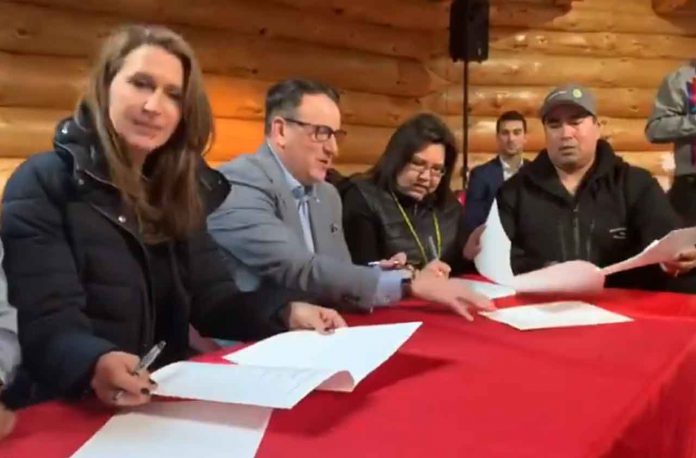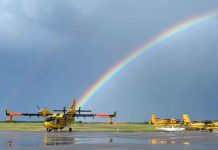KENORA – Caroline Mulroney, Minister of Transportation, and Greg Rickford, Minister of Energy, Northern Development and Mines and Indigenous Affairs took further steps to deliver on the government’s commitment to widen and twin Highway 17 between Kenora and the Manitoba border by signing a Memorandum of Understanding with Niiwin Wendaanimok, a partnership of four First Nations with interests in the project area. Widening Highway 17 will reduce travel times through highway corridors, critical trade links and international gateways while promoting economic development and safety.
Under the guidance of Elders from the four First Nations, the Ministers participated in a Manito Aki Inakonigaawin (Great Earth Law) ceremony with Ogichidaa Francis Kavanaugh, Chief Marilyn Sinclair, Washagamis Bay First Nation; Councillor Billy Wahpay, Shoal Lake 40 First Nation designate; Chief Chris Skead, Wauzhushk Onigum First Nation; and Chief Lorraine Cobiness, Niisaachewan Anishinaabe Nation. This memorandum of understanding will guide the relationship and the engagement processes for the project in the spirit of co-operation and collaboration.
Travelled by 5000-7500 vehicles each day, Highway 17 is a strategic link in the Trans-Canada Highway system. As there is no alternate route, collisions and road closures have major economic impacts both locally and nationally.
“The signing of today’s agreement with Niiwin Wendaanimok is a key milestone for this important project,” said Minister Mulroney. “We are committed to maintaining a long-term working relationship with Indigenous communities in the Kenora area to ensure the successful completion of the project. We have a shared goal to create meaningful economic opportunities for local Indigenous communities and build better transportation in Northern Ontario.”
“Today, we are one step closer to twinning Highway 17 and improving road safety for the people of Kenora-Rainy River,” said Minister Rickford. “Twinning Highway 17 is a top priority for our government and I am proud to announce that significant progress is being made. Today’s signing ceremony with the Four Winds Group marks an important milestone in the project, and we have a clear path forward to completion.”
“From time immemorial, resource-sharing in our territory has been guided by Manito Aki Inakonigaawin – our Great Earth Law. When we follow this path and its protocols, wise, fair and sustainable decisions are made for both the land and the people …for all the people who share these lands. Our collaboration with MTO is already showing the practical effectiveness of harmonizing Anishinaabe and western ways. So much more can get done –and faster –when we combine our strengths!” enthuses Chief Chris Skead, Wauzhushk Onigum First Nation.
“Everyone wants good, safe roads but, in the past, Ontario’s roads and highways have damaged our resources, our sacred places and marginalized our people. We’re hopeful that the path of partnership that we’re committing to walk with Ontario will, in fact, lead us to the Minister’s promise of meaningful economic opportunities for our people. We know that, given the chance, we have a lot to contribute,” says Councillor Billy Wahpay, Shoal Lake 40 First Nation.
“Since the announcement of this project, our Nation has been engaged with Ontario to work towards creating a partnership that respects our treaty relationship with the Crown, and the incumbent duties and responsibilities of both parties. Our Nation recognizes the province’s priorities of this project, and we continue to work with the province towards the project meeting our Nation’s priorities of meaningful economic development and respect for the treaty relationship,” states Chief Gerald Lewis, Iskatewizaagegan #39 Independent First Nation
The agreement on a collaborative relationship and process is an important and timely step for the Highway 17 project and a critical part of the province’s continued inclusive and respectful consultation with First Nation communities. Ontario remains committed to targeting shovels in the ground on section 1 of the project by summer 2020, while taking the time to hear and address any affected rights and interests and mitigate impacts related to the project.
Widening Highway 17 is part of the government’s plan to build safer and better highways to get people and goods moving.
“The twinning of the Trans-Canada Highway through Kenora is an essential project that will improve safety for travellers and pave the way for increased economic development in the Kenora riding,” federal MP Eric Melillo stated. ““I would like to thank Minister Rickford and Minister Mulroney for their work moving this project forward.”
Minister Rickford called Wednesday’s signing ceremony “an important milestone” that provides “a clear path forward to completion,” stating: “Today, we are one step closer to twinning Highway 17 and improving road safety for the people of Kenora-Rainy River.”
QUICK FACTS
|







